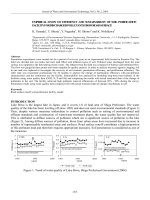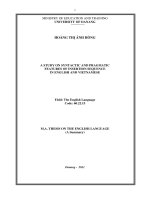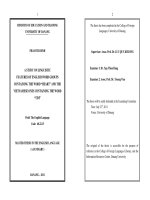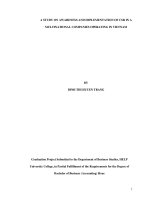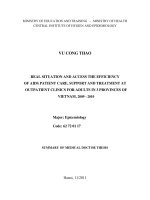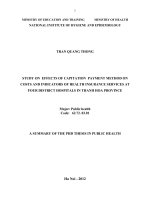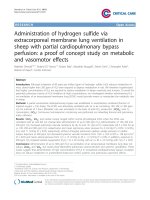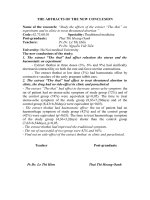study on effects of capitation payment method on cost and indicators of health insurance services at four district hospitals inthanh hoa province
Bạn đang xem bản rút gọn của tài liệu. Xem và tải ngay bản đầy đủ của tài liệu tại đây (291.09 KB, 29 trang )
1
MINISTRY OF EDUCATION AND TRAINING MINISTRY OF HEALTH
NATIONAL INSTITUTE OF HYGIENE AND EPIDEMIOLOGY
TRAN QUANG THONG
STUDY ON EFFECTS OF CAPITATION PAYMENT METHOD ON
COSTS AND INDICATORS OF HEALTH INSURANCE SERVICES AT
FOUR DISTRICT HOSPITALS IN THANH HOA PROVINCE
Major: Public health
Code: 62.72. 03.01
A SUMMARY OF THE PHD THESIS IN PUBLIC HEALTH
Ha Noi - 2012
2
THIS THESIS HAS BEEN COMPLETED AT THE
NATIONAL INSTITUTE OF HYGIENE END EPIDEMIOLYGY
Supervisors:
1. Professor. Truong Viet Dung
2. Associate Professor. Nguyen Thi Hong Hanh
Critic 1:………………………………
Critic 2:………………………………
Critic 3:………………………………
This thesis is subject to defense at the Institute-level thesis board at the
National Institute of Hygiene end Epidemiology at , , 2012.
This thesis is available at:
1. The National Library
2. The National Institute of Hygiene end Epidemiology
3
LIST OF PUBLISHED RESEARCHES
1. Trần Quang Thông, Trương Việt Dũng, Nguyễn Thị Hồng
Hạnh (2011), “Nghiên cứu ảnh hưởng của phương thức thanh toán theo
định suất đến chi phí và chất lượng khám chữa bệnh Bảo hiểm Y tế tại
Bệnh viện Đa khoa Mường Lát – Thanh Hóa”, Tạp chí Y học dự phòng,
XXI, No. 7 (125), pp.194-200.
2. Trần Quang Thông, Trương Việt Dũng, Nguyễn Thị Hồng
Hạnh (2011), “Nghiên cứu ảnh hưởng c
ủa phương thức thanh toán theo
định suất đến chi phí và chất lượng khám chữa bệnh Bảo hiểm Y tế tại
Bệnh viện Đa khoa Hà Trung – Thanh Hóa”, Tạp chí Y – Dược học Quân
sự, No. 9-2011, pp. 52-58.
4
LIST OF ABBREVIATIONS
FFS : Fee-for-service
DRG : Diagnosis-related groups
STATEMENT OF PROBLEM
Health insurance emerged in Vietnam in 1992 and has reached 60% of
Vietnamese population by 2010. A Law on Health Insurance was enacted in
late 2008 and took effect since July 2009 to propose a masterplan to making
universal health insurance by 2014 and creating a significant legal framework
for the implementation of health insurance policies.
The primary method of payment in Vietnam is FFS method, which is the
potentially risk one and has increased the abuse and escalation of medical and
administrative costs, leading to an imbalance between revenues and
expenditures of health insurance. For the past few years (2005-2009), Vietnam
has over-spent thousands of billion VND of health insurance, which has
resulted from the FFS method.
Some countries have step by step replaced FFS method with more
efficient methods of package payment and prepayment such as capitation,
payment based on specific cases or diagnosis-related groups (DRG) of
inpatients.
In accordance with the scheme of implementing the Law on Health
Insurance, all initially registered agencies will have started applying capitation
by 2015. However, there has not been any intensive study on capitation so far.
With an aim to contribute evidence to establishing and completing capitation to
make it applicable in a wider scope as well as guarantee its scientifically and
practicality, the study was conducted with following objectives:
1. To evaluate the effects of capitation on the healthcare costs under
health insurance cover in four district hospitals of Thanh Hoa province.
2. To evaluate the effects of capitation on some healthcare indicators
under health insurance cover in four district hospitals of Thanh Hoa province.
NEW CONTRIBUTIONS OF THIS STUDY
1. The study statistically proved that: the application of capitation decreased
the rise of cost, most of which was for tests, imaging diagnosis, medicine,
infusion and sending patients to the upper-level hospitals;
5
2. Compared to FFS method, capitation in the area of research was not seen
affecting several indicators of healthcare quality indicators and benefits as
well as patients’ satisfaction.
Besides, the findings of this study proved the suitability and practicality
of capitation in the area, which has provided a foundation for the expansion
of this payment scheme as proposed in the Law on Health Insurance.
ORGANIZATION OF THE STUDY
This thesis is comprised of 123 pages (excluding references and appendices),
among which there are 2 pages for problem statement , 2 pages for conclusion, 1
page for recommendations, 37 pages for chapter one, 17 pages for chapter two, 36
pages for chapter three and 29 pages for chapter 4. There are a total of 44 tables, 4
charts and 154 reference materials, among which there are 89 ones in Vietnamese
and 65 in English, being used in this thesis.
Chapter 1
OVERVIEW
1.1. Healthcare costs
1.1.1. Direct costs under health insurance cover
The basic costs covered by health insurance include the ones for:
medicine, chemicals, infusion, blood, medical procedures , tests, imaging
diagnosis, medical facilities, etc. in the scope of benefits of health insurance
regulated by the Ministry of Health.
1.1.2 Factors affecting healthcare costs
There are a number of factors affecting healthcare costs: scale of
healthcare taken by people; frequency of using medicine as well as medical
facilities and technologies; costs of medical services; method of payment;
average costs for each phase of inpatient and outpatient treatment, etc. During
the development of health insurance, there were several noteworthy trends as
follows:
- An increase in the scale of using healthcare services: In the period from
2002 to 2006, there were annually about 9 out of 100 people on average going
to public hospitals. By early 2009, the figure increased to 12 out of 100. This
rate was relatively high compared to many countries in the world, including
such developed countries as the United States (11.7), Canada (7.8) and
Singapore (9.39).
6
- An increase in the average costs for the number of outpatient care and
phases of inpatient treatments: In the period from 2003 to 2009, the costs for
inpatient and outpatient treatments under health insurance cover increased in
hospitals of all levels.
- A remarkable trend of increase in the investment in medical facilities as
well as equipment for testing and imaging: The statistics of healthcare costs
under health insurance cover demonstrated a quick increase in the proportion of
expenditures on tests and imaging diagnosis in the healthcare costs under health
insurance cover, especially in central and provincial hospitals.
- A great proportion of expenditures on medicine in total medical
expenditure: According to the annual Health Statistics Yearbooks, the average
expenditures on medicine swiftly increased and reached almost 17 USD per
capita in 2008. Besides, medicine accounted for 61% of total healthcare costs
under health insurance cover in 2009.
- A quick increase in healthcare costs resulting from the increase of
noncommunicable diseases: The treament costs for noncommunicable diseases
was many times higher than that for other communicable diseases because they
required advanced techniques, expensive specifics, long periods of treatments
and high vulnerability to complications.
The per capita medical cost of Vietnamese people was 1.1 million VND
in 2008, which was 4.6 times higher than factual costs in 1998 (or 2.3 times if
they are adjusted based on inflation indices). That was a good signal reflecting
an increase of medical investment. However, this high level of increase
compared to total medical expenditures could become a big concern if there
was any increase in the cost for inappropriate services.
* Factors in organizing healthcare networks:
The popularity of transfering patients to upper-level hospitals: Due to
this phenomenon, a number of people used healthcare services in provicial or
even central hospitals for just normal healthcare, which led to a considerable
waste of financial resources as well as other unexpected consequences.
1.2. Healthcare indicators:
The indicators evaluating the operation process and outputs enable the
measurement of quality of provided services. This evaluation is conducted by
establishing indicators evaluating the process and outputs of specific kinds of
7
diseases, based on which it be known whether the provided services for patients
have met the requirements of quality and appropriateness.
1.2.1. Definition of healthcare quality
1.2.2. An evaluation on healthcare quality
1.2.2.1. An evaluation on healthcare quality
The objective of the evaluation is to improve the efficiency of healthcare
process in the coming periods. The evaluation is to be based on the objectives,
indicators and evidences. The evaluation is usually based on theory and the
evaluation of findings is based on processes and input mechanism. The input
here signifies a resource for the healthcare system, including human resource,
material, capacity and medical technology.
Regarding the evaluation on healthcare quality, it is important to specify
requirements and standards which adequately reflect the mechanism, processes
and findings. In reality, information from medical records is usually insufficient
and lacks important factors to assess their techniques and communication.
However, utilization of medical records is still one of the primary methods of
evaluation.
In healthcare, the expectations of patients on the quantity and quality of
provided services from health agencies are regarded as their satisfaction, which
may involve many things such as time of waiting, time of treatments, provider’s
attitude, the result of the treatments, etc.
1.2.2.2. Indicators to evaluate healthcare quality
- Input indicators: human resource; equipment; finance; technical procedures;
medicine availability; medical supplies; objectives in healthcare quality; etc.
- Process indicators: working environment; direction and management of the
implementation (progress, quality, level of implementation, etc.); evaluation
of the process; support for promotion, etc.
- Output indicators: compliance with treatments procedures; health results;
indicators of improved health; patients’ satisfaction; improvement of staff
professionalism; enhancement of equipment, etc.
Chapter 2
RESEARCH SUBJECTS AND METHODS
2.1. Subjects
8
Senior executives of Vietnam’s Department of Health Insurance –
Ministry of Health - and Social Security; senior executives of Department of
Health and Social Security of Thanh Hoa province; senior executives of district
hospitals and social security; senior executives of communes’ medical stations
and owners of health insurance taking inpatient care in hospitals; medical
records and reports of balance for the healthcare costs on a quarterly basis.
2.2. Study sites
The research was carried out at four district hospitals of Thanh Hoa
province. In the plain area, Ha Trung Hospital piloted capitation with the
control of Dong Son Hospital whose payment was based on FFS method. In the
mountainous area, Muong Lat Hospital piloted capitation with the control of
Quan Son Hospital whose payment was based on FFS method.
2.3. Time
- From January 1
st
to December 31
st
, 2008: FFS method;
- From January 1
st
to December 31
st
, 2009: pilot capitation.
2.4. Methods
2.4.1. Study design
Methods in this study were comparative description, (between before and
after adopting capitation) with control (on FFS method) together with method
of referring to secondary statistics and social health investigation. Quantitative
and qualitative methods were also utilized.
2.4.2. Sample size and sampling methods
- Outpatients: all collective sheets of outpatients’ costs and common
prescriptions (03 cases) for those diagnosed with acute bronchitis, acute
gastritis – duodenitis, primary hypertension. In reality, 3.073 sheets were
collected.
- Inpatients: all collective sheets of costs and common medical records (5
cases) for those diagnosed with acute bronchitis; acute gastritis – duodenitis;
primary hypertension; appendicitis (classical operating); and Caesarean section.
In reality, 2.080 sheets were collected.
- Satisfaction of patients taking inpatient care: 50 patients in each hospital
were randomly selected for interviewing.
2.4.3. Method of data collection
Qualitative method
9
- Six direct interviews with senior executives of Department of Health
Insurance, board of implementing health insurance policies, senior executives
of Ha Trung and Muong Lat hospitals, senior executives of social security of
Ha Trung and Muong Lat districts. Six discussions among staff and senior
executives of Department of Health; staff and senior executives of social
security in Thanh Hoa province; staff and senior executives of faculties,
departments as well as doctors directly treating patients possessing health
insurance and heads of commune medical stations.
Quantitative method
- Calculate healthcare costs gained from the recordes on healthcare costs
in the two years of 2008 and 2009.
- Direct interviews with patients taking inpatient care and having
discharged from hospitals, using structured questionnaires (50 patients in each
hospital). Direct interviews with senior executives from deputy chiefs of
departments (faculties) upwards, using structured questionnaires at two
hospitals piloting capitation (17 senior executives from Ha Trung Hospital and
20 ones from Muong Lat Hospital).
2.4.4. Contents
Evaluative indicators in the research
¾ Objective 1. To evaluate the effects of capitation on the healthcare costs
under health insurance cover in four district hospitals.
- The growth rate of average costs per number of medical visits in commune,
district inpatient and outpatient, provincial and central hospitals;
- The growth rate of total cost in commune; district inpatient and outpatient;
provincial and central hospitals;
- The average growth rate per card per year based on health insurance subjects;
- The growth rate of medical costs, tests and imaging diagnosis per number of
medical visits in outpatient district hospitals;
- The growth rate of medical costs, tests and imaging diagnosis per number of
medical visits in inpatient district hospitals;
- The growth rate of total medical costs, tests and imaging diagnosis in
outpatient district hospitals;
- The growth rate of average medical costs per number of medical visits in
inpatient district hospitals;
10
- The growth rate in average testing costs per number of medical visits in
inpatient district hospitals;
- The growth rate of average costs for imaging diagnosis per number of medical
visits in inpatient district hospitals;
- The growth rate of total medical costs, tests and imaging diagnosis in inpatient
district hospitals;
- Indicators affecting the costs at hospitals adopting capitation, etc.
¾ Objective 2. To evaluate the effects of capitation on some healthcare
indicators under health insurance cover.
- To compare the degree of compliance with disease-based treatments;
- To compare the degree of treatment results/outcomes;
- To compare the degree of patients’ satisfaction;
- Frequency of medical visits;
- Average number of days of inpatient treatments per course of treatment;
- Several factors of capitation affecting healthcare quality as well as hospital
activities.
2.4.5 Research variables and several definitions used in the research
- The formula to calculate the average cost:
X
=
n
x
i
∑
In which:
X
: The average cost;
xi: The expenditures (for treatment phases, medicine, blood,
etc.) in each treatment phase (or each medical /episode);
n: The number of treatment phases or medical visits/episode on
a yearly basis.
- The formula to calculate the cost growth rate in 2009 compared to 2008:
The cost growth rate (%) = {(in 2009 – in 2008)/in 2008}*100.
2.4.6 Data processing: The data were collected from reports and sets of tools.
Excel software was used to input data whereas SPSS to process and analyze
data. Costs in 2008 were adjusted in terms of value whereas in 2009 Consumer
Price Index (CPI) was adopted (gso.org.vn). The CPI was 100 in 2008 and
106.9 in 2009. Statistical analysis using Z test (Prtesti n
1
p
1
n
2
p
2
) identified
difference of statistical significance between two rates. Value p {p(Ztest)}
11
verified the difference and with p<0,05 the difference was of statistical
significance.
2.5. Research ethics: not to be considered
12
Chapter 3
FINDINGS
3.1. Effects of capitation on the growth of healthcare costs under health insurance cover
3.1.1. Effects of capitation on the growth of healthcare costs under health
insurance cover
Table 3.1. Average costs/ number of visits under health insurance based on
levels of hospitals.
In the plain area Unit: 1000 VND
Level of
hospital
Ha Trung Dong Son
P
FFS
(2008)
Capitation
(2009)
Increase
(%)
FFS
(2008)
FFS
(2009)
Increase
(%)
Commune 25 22 -11,2 18 22 22,0 <0,05
District
outpatient
89 97 9,8 108 142 31,3 <0,05
District
inpatient
807 789 -2,2 683 675 -1,1 >0,05
Provincial 1.451 1.511 4,2 1.204 1.336 11,0 <0,05
Central 3.167 3.366 6,3 2.775 3.087 11,2 <0,05
General 207 234 12,9 230 299,5 30,2 <0,05
In the mountainous area
Muong Lat Quan Son
Commune 18,99 18,8 -0,8 29 38 25,5 <0,05
District
outpatient
103 90 -12,2 125 133 5,7 <0,05
District
inpatient
550 589 7,1 542 582 7,4 >0,05
Provincial 1.371 1.574 14,9 1.275 1.571 23,3 <0,05
Central 1.381 6.594 377,7 3.487 3.209 -8,0 <0,05
General 162,4 163 0,4 140 189 35,0 <0,05
* Costs in 2008 were adjusted in terms of value whereas in 2009
Consumer Price Index (CPI) was adopted (gso.org.vn).
Table 3.1 shows that the growth rate of the average costs per each
medical visit in hospitals adopting pilot capitation was lower than that of
hospitals adopting FFS method. That difference was of statistical significance
in both plain and mountainous areas in commune, district inpatient and
outpatient as well as provincial hospitals. The cost growth rate in commune and
district inpatient hospitals of plain area together with commune and district
outpatient hospitals of mountainous area even decreased. Particularly the
13
growth rate in central hospitals rose to 377.4% in a hospital piloting capitation
in Muong Lat. Besides, the difference between the growth of average cost per
number of medical visits in the inpatient hospital of Muong Lat district and that
of Quan Son district was not of statistical significance. The obvious difference
lay in commune, district outpatient and general hospitals in both plain and
mountainous areas.
Table 3.2. Total expenditures for health insurance based on levels of
hospitals.
In the plain area Unit: million VND
Level of
hospital
Ha Trung Dong Son
P
FFS
(2008)
Capitation
(2009)
Increase
(%)
FFS
(2008)
FFS
(2009)
Increase
(%)
Commune 490 429 -12,4 608 806 32,8 <0,05
District
outpatient
2.506 3.176 26,9 3.505 4.312 23,1 <0,05
District
inpatient
4.669 5.907 26,6 3.587 4.768 33,0 <0,05
Provincial 1.736 2.457 41,7 7.709 11.780 53,0 <0,05
Central 2.237 2.484 11,1 2.614 3.371 29,1 <0,05
General 11.639 14.454 24,3 18.023 25.037 39,1 <0,05
In the mountainous area
Muong Lat Quan Son
Commune 97 102,2 5,8 422 516,7 22,7 <0,05
District
outpatient
1.487 1.196 -19,5 1.210 1.395 15,4 <0,05
District
inpatient
1.684 1.694 0,6 1.098 1.802 64,4 <0,05
Provincial 429 563 31,0 778 1.438 84,9 <0,05
Central 26 112 327,4 237 275,9 16,4 <0,05
General 3.723 3.665 -1,5 3.745 5.428 45,1 <0,05
Table 3.2 shows that the growth rate of total expenditures based on levels
of hospitals in 2009 compared to 2008 in hospitals piloting capitation was lower
than those adopting FFS method. That difference was of statistical significance
in both plain and mountainous areas as well as all commune, district outpatient
and inpatient, provincial and central hospitals. Like table 3.1, the growth rate of
total expenditures in commune hospitals of plain area together with district
outpatient and general hospitals of mountainous area even decreased. The
growth rate of total expenditures of patients transferred from Muong Lat to
14
central hospitals was 327.2%. The difference in total expenditures of district
inpatient hospitals had a statistical significance.
Table 3.3. Average costs/card/year based on subjects.
In the plain area Unit: 1000 VND
Subject
Ha Trung Dong Son
P
FFS
(2008)
Capitation
2009)
Increase
(%)
FFS
2008)
FFS
(2009)
Increase
(%)
Mandatory 399 501 25,7 733 855 16,7
<0,05
The poor 123 123 -0,2 177 256 44,6
<0,05
Students 54 95 77,6 77 95 23,1
<0,05
People 594 598 0,6 629 720 14,5
<0,05
General 205 252 22,9 352 476 35,3
<0,05
In the mountainous area
Muong Lat Quan Son
Mandatory 416 246 -40,9 556 416 -25,2
<0,05
The poor 129 116 -10,5 93 121 30,7
<0,05
General 147 126 -14,7 129 155 20,0 <0,05
Table 3.3 reveals that the growth rate of average costs of one card per year in
hospitals piloting capitation was lower than those in hospitals adopting FFS
method. That difference was of statistical significance in both plain and
mountainous areas, for all subjects of mandatory, the poor, people and general.
Particularly the rate among students in the plain area increased 77.6%. The
growth rate of average costs per card per year among the poor were more
evident than that of other groups.
3.1.3. Healthcare costs in district hospitals
Table 3.8. Total healthcare expenditures in district inpatient and outpatient
hospitals.
In the plain area Unit: million VND
Subject
Ha Trung Dong Son
P
FFS
(2008)
Capitation
(2009)
Increase
(%)
FFS
(2008)
FFS
(2009)
Increase
(%)
Outpatient 2.504 3.176 26,9 3.502 4.312 23,1
<0,05
Inpatient 4.665 5.907 26,6 3.584 4.768 33,0
<0,05
Total 7.169 9.084 26,7 7.086 9.080 28,1
<0,05
In the mountainous area
Muong Lat Quan Son
Outpatient 1.485 1.196 -19,5 1.209 1.395 15,4
<0,05
Inpatient 1.683 1.604 -4,7 1.097 1.803 64,4
<0,05
Total 3.168 2.799 -11,6 2.306 3.198 38,7
<0,05
15
Table 3.8 shows that:
- The growth rate of total healthcare costs in district inpatient and
outpatient hospitals piloting capitation was lower than that of hospitals
accepting FFS method. That difference was of statistical significance in both
plain and mountainous areas for both inpatient and outpatient hospitals. For
outpatient hospitals, the growth rate of total expenditure of Muong Lat hospital
even decreased. Particularly the growth rate of total expenditure for outpatients
at Ha Trung hospital was higher than other groups, which was of statistical
significance ( p<0,05).
- The difference in the growth rate of inpatient groups was more evident
than in the outpatient groups.
* Healthcare costs categorized by items:
Table 3.10. Total expenditure for outpatient district hospitals categorized by items.
In the plain area Unit: million VND
Items
Ha Trung Dong Son
P
FFS
(2008)
Capitation
(2009)
Increase
(%)
FFS
(2008)
FFS
(2009)
Increase
(%)
Examinatio
n fees
61 66 8,1 69 69,3 0,1 <0,05
Medicine 1.322 1.824 38,0 2.116 2.593 22,5 <0,05
Tests 457 572 25,1 526 675 28,4 <0,05
Imaging 532 599 12,6 762 940 23,5 <0,05
Techniques 132 115 -12,5 28 34 19,1 <0,05
Total 2.504 3.176 26,9 3.502 4.312 23,1 <0,05
In the mountainous area
Muong Lat Quan Son
Examinatio
n fees
31 27 -15,2 21 20,9 1,5 <0,05
Medicine 1.258 1.011 -19,6 819 896 9,3 <0,05
Tests 115 90 -21,4 293 391 33,2 <0,05
Imaging 80 62 -22,5 75 88 16,3 <0,05
Techniques 735 5.059 587,9 0 0 0 <0,05
Total 1.485 1.196 -19,5 1.209 1.395 15,4 <0,05
Table 3.10 shows that the growth rate of total healthcare cost of
outpatients in hospitals adopting pilot capitation was lower than in those
accepting FFS method. That difference was of statistical significance in both
plain and mountainous areas for testing, imaging and total expenditure. As for
examination fees, medicine, testing, imaging and total expenditure in Muong
16
Lat, the growth rate even decreased. Particularly for the examination fees,
medicine and total expenditure in Ha Trung, the growth rate was higher than
other groups, which was of statistical significance (p<0,05).
Table 3.13. Analysis of total healthcare cost in inpatient district hospitals
categorized by items.
In the plain area Unit: million VND
Items
Ha Trung Dong Son
P
FFS
(2008)
Capitation
(2009)
Increase
(%)
FFS
(2008)
FFS
(2009)
Increase
(%)
Bed fees 312 338 8,3 213 296 38,9 <0,05
Medicine 2.089 2.831 35,5 2.125 2.834 33,4 <0,05
Blood 5,8 3,9 -33,2 0 1,3 0 NA
Tests 762 946 24,0 575 776 35,1 <0,05
Imaging 428 472 10,3 229 323 41,5 <0,05
Techniques 942 1.214 28,9 318 338 6,4 <0,05
Medical
supplies 126 103 -18,4
125 198 58,8 <0,05
Total 4.665 5.907 26,6 3.584 4.768 33,0 <0,05
In the mountainous area
Muong Lat Quan Son
Bed fees 110 90 -17,9 85 121 42,9 <0,05
Medicine 897 942 5,0 611 1.030 68,6 <0,05
Blood 0 520 0! 0 0 0! NA
Tests 329 302 -8,4 125 212 70,1 <0,05
Imaging 86 70 -18,7 68 118 72,5 <0,05
Techniques 136 156 14,8 149 214 44,2 <0,05
Medical
supplies 124 133 6,8 59 107 81,0
<0,05
Total 1.683 1.694 0,6 1.097 1.802 64,4 <0,05
Table 3.13 shows that the growth rate of total healthcare cost of
outpatients in hospitals adopting pilot capitation was lower than in those
accepting FFS method. That difference was of statistical significance in both
plain and mountainous areas for fees of bed fees, tests, imaging, medical
supplies and total expenditure. As for fees of bed, test, imaging and total
expenditure in Muong Lat, the growth rate even decreased. Particularly for the
total expenditure for medicine in Ha Trung, the growth rate was higher than
other groups (35,5% compared to 33,4%), which was of statistical significance.
The lower growth rate resulted from the decreased expenditure in items of bed
fees, test, imaging diagnosis and medical supplies.
17
3.1.7. Some indicators related to healthcare costs under health insurance
cover.
Table 3.21. Some factors of capitation affecting healthcare costs
Content
Ha Trung Muong Lat Total
n = 17 % n = 20 % n = 37 %
Hospitals gained
initiative to use financial
resources efficiently
17 100 20 100 37 100
Hospitals reduce
unnecessary testing fees
17 100 19 95,0 36 97,3
Reducing budget abuse 13 76,5 20 100 33 89,2
Controlling of patients’
transfering
17 100 16 80,0 33 89,2
Awards for excellent
perfomances and surplus
budget
11 64,7 17 85,0 28 75,7
Social security agencies
know in advance the
amount of expenditure to
cover
17 100 17 85,0 34 91,9
Less supervision on
abuse
10 58,8 12 60,0 22 59,5
Administrative costs in
capitation decreased
compared to FFS
method
16 94,1 18 90,0 34 91,9
Table 3.21 shows that 100% of senior executives in two hospitals
adopting pilot capitation thought that hospitals could gain initiative to use
financial resources efficiently, which reduced unnecessary testing fees (97.3%),
reduced budget abuse (89.2%), controlled patients’ referral to higher levels
(89.2%) and reduced administrative costs (91.9%).
3.2. EFFECTS OF CAPITATION ON SOME HEALTHCARE INDICATORS
3.2.1. Effects on healthcare quality under health insurance cover
The evaluation of healthcare quality in this study was based on some
indicators from medical records of 5 inpatients diagnosed with acute bronchitis,
acute gastritis, primary hypertension, acute appendicitis and Caesarean section
as well as direct interviews on the guarantee of benefits and satisfaction of 50
18
patients in each hospital on being discharged. The results were obtained as
follows:
3.2.1.1. Compliance with treatments
Table 3.22. Degree of compliance with treatments of some internal
diseases
In the plain area Unit: %
Compliance
Ha Trung Hospital Dong Son Hospital
p
FFS
(2008)
Capitation
(2009)
FFS (2008) FFS (2009)
Acute
bronchitis
n = 129 n = 74 n = 156 n = 95
>0,05
12
4
96,1
72 97,3 150 96,2 92 96,8
Acute
gastritis
n = 74 n = 110 n = 77 n = 54
>0,05
71 95,9 107 97,3 76 98,7 53 98,1
Primary
hypertension
n = 95 n = 180 n = 72 n = 52
>0,05
93 97,9 178 98,9 69 95,8 52 100
In the mountainous area Unit: %
Muong Lat Quan Son
Acute
bronchitis
n = 22 n = 37 n = 98 n = 27
>0,05
21 95,5 36 97,3 93 94,9 26 96,3
Acute
gastritis
n = 24 n = 56 n = 98 n = 23
>0,05
23 95,8 55 98,2 95 96,9 22 95,7
Primary
hypertension
n = 13 n = 18 n = 20 n = 51
<0,05
10 76,9 16 88,9 19 95,0 47 92,2
Table 3.22 reveals that the degree of compliance with treatments of
internal diseases (acute bronchitis, acute gastritis, primary hypertension) in
hospitals piloting capitation (Ha Trung Hospital: 97,3%- 98,9%; Muong Lat
Hospital: 88,9%- 98,2%) was no different from hospitals adopting FFS method
(Dong Son Hospital: 96,8%- 100,0%; Quan Son Hospital: 92,2%- 96,3%).
There was particularly a difference of statistical significane in the degree of
compliance with treatments of primary hypertension in the mountainous area.
19
Table 3.23. Degree of compliance with treatment regimens for some surgical
diseases
In the plain area Unit: %
Diagnoses
Ha Trung Hospital Dong Son Hospital
p
FFS (2008)
Capitation
(2009)
FFS (2008) FFS (2009)
Acute
appendicitis
n = 32 n = 15 n = 40 n = 36
>0,05
29 90,6 14 93,3 37 92,5 34 94,4
Caesarean
section
n = 31 n = 60 n = 49 n = 52
>0,05
30 96,8 58 96,7 48 98,0 49 94,2
In the mountainous area Unit: %
Muong Lat Hospital Quan Son Hospital
Acute
appendicitis
n = 10 n = 18 n = 13 n = 8
>0,05
9 90,0 17 94,4 11 84,6 7 87,5
Caesarean
section
n = 13 n = 17 n = 14 n = 17
>0,05
11 84,6 16 94,1 12 85,7 16 94,1
Table 3.23 shows the degree of compliance with treamtments of surgical
diseases (acute appendicitis, Caesarean section) in hospitals piloting capitation
(Ha Trung hospital: 93,3% and 96,7%; Muong Lat Hospital: 94,4% and 94,1%)
was not different from hospitals adopting FFS method (Dong Son Hospital:
94,4% and 94,2%; Quan Son Hospital: 87,5% and 94,1%).
3.2.1.2. Treatment results
Table 3.24. Results of treatment for acute bronchitis
In the plain area
Treatment
results
Ha Trung Hospital Dong Son Hospital
p
FFS (2008)
Capitation
(2009)
FFS (2008) FFS (2009)
n=129 % n=
74
% n=156 % n=
95
%
Recovered 116 89,9 70 94,6 138 88,5 85 89,5 >0,05
Stabilized 11 8,5 3 4,1 16 10,3 9 9,5 NA
Transfered 2 1,6 1 1,4 2 1,3 1 1,1 NA
In the mountainous area
Muong Lat Hospital Quan Son Hospital
n= 22 % n=
37
% n= 98 % n=
27
%
Recovered 19 86,4 33 89,2 85 86,7 23 85,2 >0,05
Stabilized 2 9,1 3 8,1 12 12,2 3 11,1 NA
Transfered 1 4,5 1 2,7 1 1,0 1 3,7 NA
20
Table 3.24 shows the rate of successful treatment of acute bronchitis in
hospitals piloting capitation (Ha Trung Hospital: 94,6%; Muong Lat Hospital:
89,2%) was not different from hospitals adopting FFS method (Dong Son
Hospital: 89,5%; Quan Son Hospital: 85,2%).
Table 3.25. Result of treatment for acute gastritis.
In the plain area
Treatment
result
Ha Trung Hospital Dong Son Hospital
p
FFS (2008)
Capitation
(2009)
FFS (2008) FFS (2009)
n= 74 % n=110 % n= 77 % n= 54 %
Stabilized 67 90,5 99 90,0 70 90,9 50 92,6
>0,05
Relieved 6 8,1 9 8,2 6 7,8 3 5,6
NA
Transfered 1 1,4 2 1,8 1 1,3 1 1,9
NA
In the mountainous area
Muong Lat Hospital Quan Son Hospital
n= 24 % n = 56 % n= 98 % n= 23 %
Stabilized 21 87,5 50 89,3 87 88,8 21 91,3
>0,05
Relieved 2 8,3 5 8,9 10 10,2 2 8,7
NA
Transfered 1 4,2 1 1,8 1 1,0 0 0
NA
Table 3.25 shows the rate of stable treatment for acute gastritis in hospitals
piloting capitation (Ha Trung Hospital: 90,0%; Muong Lat Hospital: 89,3%) was
not different from hospitals adopting FFS method (Dong Son Hospital: 92,6%;
Quan Son Hospital: 91,3%).
Table 3.26. Result of treatment for primary hypertension
In the plain area
Treatment
result
Ha Trung Hospital Dong Son Hospital
p
FFS (2008)
Capitation
(2009)
FFS (2008) FFS (2009)
n = 95 % n= 180 % n = 72 % n= 52 %
Stabilized 84 88,4 166 92,2 66 91,7 48 92,3
>0,05
Recovered 10 10,5 13 7,2 5 6,9 3 5,8
NA
Transfered 1 1,1 1 0,6 1 1,4 1 1,9
NA
Khu vực miền núi
Muong Lat Hospital Quan Son Hospital
n = 13 % n = 18 % n = 20 % n= 51 %
Stabilized 11 84,6 16 88,9 18 90,0 44 86,3
>0,05
Relieved 2 15,4 2 11,1 1 5,0 7 13,7
NA
Transfered 0 0 0 0 1 5,0 0 0
NA
Table 3.26 shows that the rate of stable treatment for primary
hypertension in hospital piloting capitation (Ha Trung Hospital: 92,2%; Muong
21
Lat Hospital: 88,9%) was not different from hospitals adopting FFS method
(Dong Son Hospital: 92,3%; Quan Son Hospital: 86,3%), (p>0,05).
Table 3.4. Rate of stable treatment for primary hypertension.
Table 3.27. Result of treatment for appendicitis.
In the plain area
Treatment
results
Ha Trung Hospital Dong Son Hospital
p
FFS (2008)
Capitation
(2009)
FFS (2008) FFS (2009)
n= 32 % n =15 % n= 40 % n= 36 %
Recovered 31 96,9 15 100,0 39 97,5 35 97,2 >0,05
Stabilized 1 3,1 0 0 1 2,5 1 2,8 NA
In the mountainous area
Muong Lat Hospital Quan Son Hospital
n= 10 % n= 18 % n= 13 % n= 8 %
Recovered 10 100,0 18 100,0 13 100,0 8 100,0 >0,05
Stabilized 0 0 0 0 0 0 0 0 NA
Table 3.27 shows a difference which was not of statistical significance
between the rate of successful treatment of acute appendicitis in hospitals
piloting capitation and that in hospitals adopting FFS method (p>0,05).
Table 3.28. Result of treatment for Caesarean section.
In the plain area
Treatment
result
Ha Trung Hospital Dong Son Hospital
p
FFS (2008)
Capitation
(2009)
FFS (2008) FFS (2009)
n=
31
% n =
60
% n=
49
% n=
52
%
Recovered 31 100,0 60 100,0 48 98,0 52 100,0 >0,05
Stabilized 0 0 0 0 1 2,0 0 0 NA
In the mountainous area
Muong Lat Hospital BV Quan Son
n=
13
% n =
17
% n=
14
% n=
17
%
Recovered 12 92,3 16 94,1 14 100,0 17 100,0 >0,05
Stabilized 1 7,7 1 5,9 0 0 0 0 NA
Table 3.28 shows a difference difference which was not of statistical
significance between the rate of successful treatment of Caeserean section in
hospitals piloting capitation and that in hospitals adopting FFS method
(p>0,05).
22
3.2.1.5. Patients’ satisfaction
Table 3.32. Inpatients’ satisfaction (n=50).
Content
In the plain area In the mountainous
area
p
Ha Trung
Capitation
Dong
Son
(FFS)
Muong
Lat
Capitation
Quan Son
(FFS)
Being satisfied with
healthcare procedures
94,0 94,0 96,0 96,0 >0,05
Being satisfied with
service attitudes
96,0 96,0 98,0 97,0 >0,05
Being satisfied with
healthcare waiting time
98,0 96,0 96,0 96,0 >0,05
Being satisfied with
treatment results
94,0 94,0 98,0 98,0 >0,05
Table 3.32 shows that the inpatients’ satisfaction with healthcare
procedures, service attitudes, healthcare waiting time and treatment results in
hospitals piloting capitation and those adopting payment on FFS method both
reached from 94% to 98%. The difference was not of statistical significance
(p>0,05).
3.2.3. Some indicators related to healthcare quality under health insurance cover
Table 3.34. Effects of capitation on healthcare quality under health insurance
cover.
Content
Ha Trung Muong Lat Total
n = 17 % n = 20 % n = 37 %
Encouring hospitals to
improve
professionalism.
17 100,0 14 70,0 31 83,8
Encouraging hospitals
to invest in equipment
17 100,0 15 75,0 32 86,5
Health staff treat
patients better
17 100,0 18 90,0 35 94,6
Health insurance staff
guarantee the benefits
of insurance card
holders
16 94,1 20 100,0 36 97,3
To guarantee and meet
the healthcare demands
of insurance card
holders
17 100,0 20 100,0 37 100
23
Table 3.34 shows that 100% of senior executives in two hospitals piloting
capitation saying that the hospitals guaranteed and met healthcare demands of
insurance card holders. Besides, capitation made health insurance staff
guarantee the benefits for insurance card holders (97,3%), health staff treat
patients better (94,6%); encouraging hospitals invest in equipment (86,5%) and
improve professionalism (83,8%).
3.2.3. Effects of capitation on hospital work
Table 3.37. Balance of fund for capitation at Ha Trung and Muong Lat
Hospitals
Unit: million VND
Total expenditure based on levels of hospital Muong Lat Ha Trung
Commune 102 429
District 2.889 9.084
Multi-level internal provincial 562 2.457
Multi-level external provincial 112 2.484
Total expenditure 3.665 14.454
Fund for capitation 4.346 12.438
Balance of fund for capitation 681 - 2.015
Table 3.37 shows that with pilot capitation in 2009, Muong Lat Hospital
had a surplus of 681 million VND and Ha Trung Hospital had a deficit of 2.015
billion VND in the fund for capitation.
Chapter 4.
DISCUSSIONS
4.1. Effects of capitation on healthcare costs health insurance covered
The pilot capitation is a method of package payment in which a certain
amount of money is extracted from health insurance fund to health facilities
based on the number of health insurance cardholders who initially register
healthcare services at those health facilities multiplying by capitation based on
regions. This budget is called health insurance fund based on capitation at
health facilities and used to pay general healthcare expenditures of those who
register healthcare services at those health facilities. The expenditures
mentioned in this study are the direct expenditures for patients in the scope of
health insurance benefits, including examination charges, bed fees, technical
24
service charges, test charges, imaging fees together with charges of medicine,
blood and medical supplies.
The evaluation in this study was conducted through comparing growth
rates of average cost per number of /episodes, healthcare expenditures under
health insurance cover in hospitals of all levels as well as the structure of
healthcare expenditure in district inpatient and outpatient hospitals which were
directly affected by the capitation.
The findings of this study showed that:
- In both plain and mountainous areas: the growth rate of average cost
per number of medical visits/episodes in all levels of hospitals piloting
capitation was lower than that in hospitals adopting FFS method, which was a
difference of statistical significance with p<0,05. The growth rate of average
cost per card per year among subjects and hospitals piloting capitation was
lower than that in hospitals adopting FFS method, which was a difference of
statistical significance with p<0,05. People asked in both plain and
mountainous areas said that capitation had helped hospitals gain initiative to
use financial resources efficiently.
Thus, in both plain and mountainous areas, the cost growth rates in
hospitals piloting capitation were lower than those in hospitals adopting FFS
method. The matter was that what capitation had helped to reduce in
expenditures? The results of growth rate based on the structure of expenditures
at inpatient and outpatient district hospitals reveal that: the average costs per
number of medical visits/episodes and total outpatient expenditures for tests,
imaging diagnosis in district hospitals piloting capitation were lower than those
in hospitals adopting FFS method; the growth rate of average costs per number
of medical visits and total inpatient expenditures for tests, imaging diagnosis in
district hospitals piloting capitation were lower than those in hospitals adopting
FFS method, which was a difference of statistical significance with p<0,05;
the growth rate of average costs per number of medical visits/episodes and
total inpatient expenditures for beds in district hospitals piloting capitation were
lower than those in hospitals adopting FFS method, which was a difference of
statistical significance with p<0,05.
On the other hand, the findings of the direct interviews show that: 100%
of asked senior executives in two hospitals piloting capitation said that “The
hospital has gained initiative to use financial resources efficiently”. 97.3% of
25
asked people said that the efficient use of financial resources had helped reduce
unnecessary test charges, 89,2% said it had helped reduce budget abuse by health
staff and insurance card holders, and 89.2% said it had helped control
inappropriate patients’ transferring. The initiative to efficiently use financial
resources resulted from a mechanism of capitation which encouraged health
facilities that any surplus could be used as hospital charges or extracted for gifts
as regulated in Decree No. 43/NĐ/CP on financial self-control in hospitals
(75,7% of asked people regarded this mechanism as a reason). Besides, some
asked people also said that capitation had helped reduce efforts to control
expenditures compared to FFS method (59,5%) and 91,9% of asked people said
that administrative costs had reduced thanks to capitation compared to FFS
method.
Hence, the capitation restrict the rise of expenditures by decreasing abuse
in charges for tests, imaging diagnosis, beds as well as controlling patients’
transferring to reduce unnecessary charges in comparison with hospitals
adopting FFS method.
4.2 Effects of capitation on some healthcare indicators under health
insurance cover
4.2.1 Evaluation of healthcare quality
The evaluation of some healthcare quality indicators under health
insurance cover was conducted by comparing the degree of compliance with
inpatient disease-based treatments, average days of treatment and patients’
satisfaction, etc. The findings show that: the degree of compliance with
treatments and treatment results for acute bronchitis, acute gastritis, primary
hypertension, appendicitis and Caeserean section all reached above 85% and no
difference was seen between capitation and FFS method; the high rate of
interviewed patients (94% - 98%) showed their satisfaction with healthcare
procedures, service attitudes, healthcare waiting time and treatment results.
Some indicators of healthcare benefits of insurance card holders all reached
above 92% and no difference was seen between capitation and FFS method;
capitation in district hospitals encouraged hospitals to improve
professionalism (83,8%), invest in equipment (86,5%) in order to guarantee
the benefits and meet the healthcare demand of insurance holders; the average
number of days of treatment based on capitation reduced to 08 days/course.
